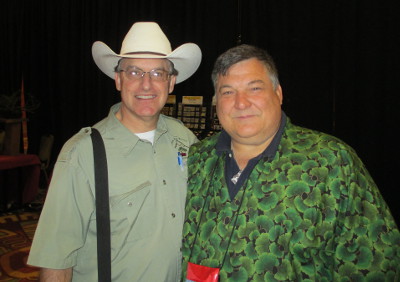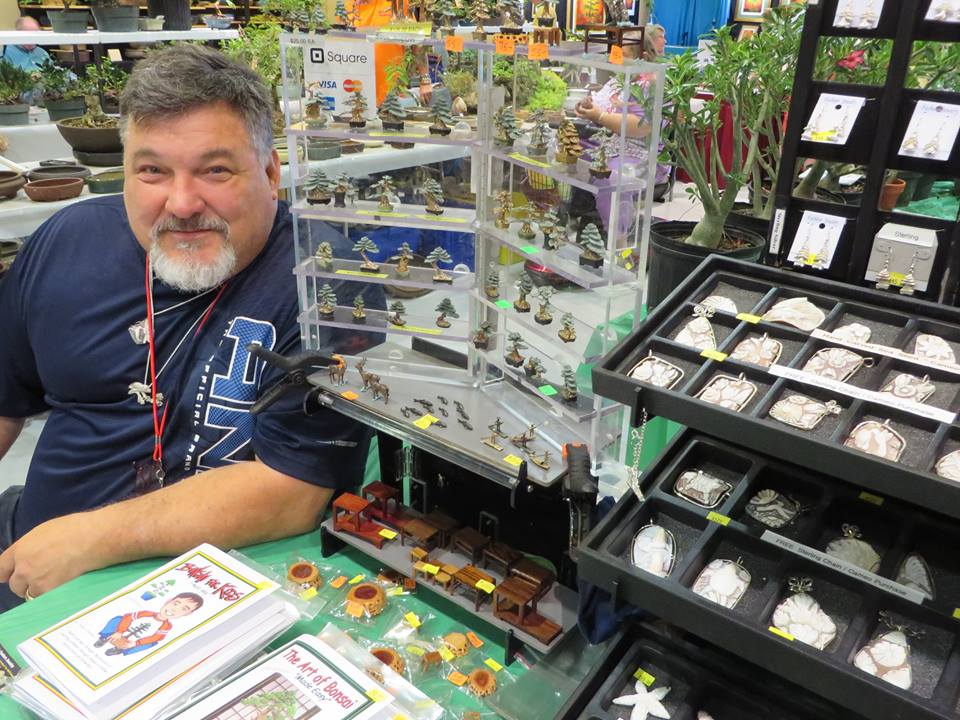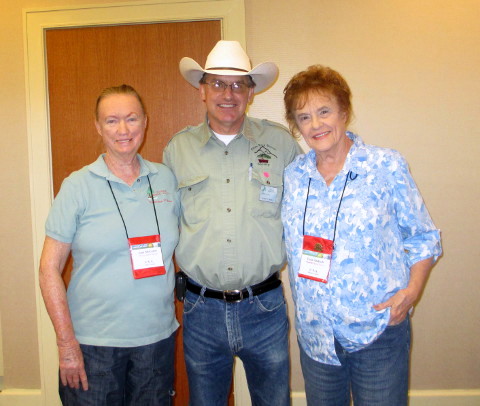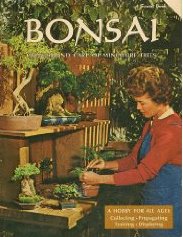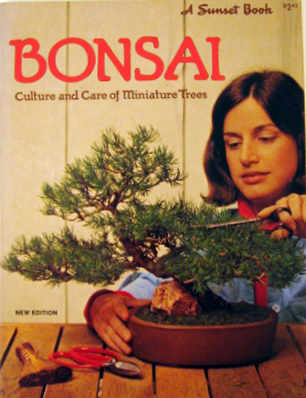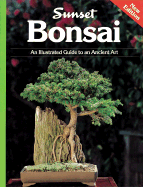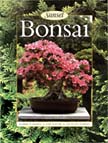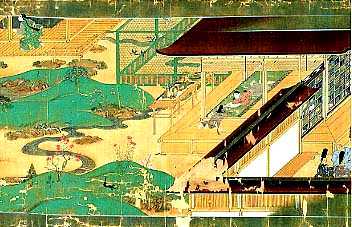| 21 |
1975 -- From today through the 26th, after the 53 bonsai and 6 suiseki were officially presented to the U.S.
by the Nippon Bonsai Association, an indoor exhibit for the general public was held at the Tokyo Bonsai Club
in Ueno Park before the Bicentennial Gift was carefully shipped to America for a quarantine period before its
debut at the National Arboretum. Please see this video
of the story, Bonsai Fly to U.S.A..
There is also this Japanese
language video which includes other materials.
SEE ALSO: Feb 19, Mar 20, Jul 9, Jul 21
2003 -- Mary E. Mrose, multi-talented grand-dame of the Northern Virginia Bonsai Society of the Potomac Bonsai Society, died. She was a major benefactor of the National Bonsai and Penjing Museum. (Personal e-mail from Betty V. Yeapanis to RJB, March 24, 2003) SEE ALSO: May 2, May 17 |
||||
| 22 |
1892 -- Otto Lee Holdakowski was born in New Orleans, Louisiana. [He would enlist in the U.S. Navy in
1910 as an apprentice seaman, and then during the ensuing two years would serve on ships in far Eastern
waters. While visiting the tea gardens in Tokyo, Nagasaki and Yokohama, he would see pretty geisha
girls attending bonsais -- the first dwarf trees he would have ever seen. While in Japan he would
collect bonsai books and study under old Japanese masters. When he would say good-bye to Japan, he would
carry six fine little trees home to New Orleans. [He would be listed in the 1920 U.S. Census as living with his parents and sister, Amelia, in New Orleans Ward 17, Orleans Parish, Louisiana. In the 1930 U.S. Census, Lee would be noted as living in Berkeley, Alameda County, California with spouse Loretta D. and four-year-old son, George (named after Otto's father). On Oct. 1, 1937 with a San Leandro, Alameda County address, his wife would give birth to daughter Dorothy Lee. Per a 1943 article, this retired United States naval officer, then residing in the San Fernando Valley, just west of Hollywood, in Los Angeles County, would be said to have the largest collection of dwarf trees in the United States and one of the largest in the world. Held in his tree yard and two lofty greenhouses, the collection would be valued at $100,000 (the equivalent of about $1.649 million in 2022). Three hundred evergreens, three hundred maples of twenty-two varieties, one hundred Chinese elms, one hundred fruit trees, and numerous miscellaneous trees made up the collection. Some of his specimens would have been acquired by Holdakowski in the local Sierra Nevada Mountains, while others would have come over the previous thirty years from more colorful adventures: "In China he has trekked through the mountains of Shansi province with a mule caravan. In India he hunted and found dwarf trees in the Himalaya mountains of Nepal. From Asmara, Italian Eritria, he journeyed south into the mountainous plateau country of Ethopia. He almost lost his life in a bandid raid while caravaning on the bonsai trail in the Chilean Andes. Through the years he has also made trips into the Oaxacan mountains of southern Mexico, into Central America and Peru." [It would be said that "most credit for introducing the art of bonsai to America must go to Lee Holdakowski. Through lectures and exhibitions in the West he has shown bonsais to hundreds of thousands of people." A three-foot tall California live oak, estimated to be two hundred years old, would be said to have been awarded a blue ribbon and first prize in the Los Angeles 1941 Mid-Winter Flower Show.] [How and for how long did he study under old Japanese masters? Our researches to date cast doubt on the ability of a young American in the navy around the turn of the 20th century with no demonstrated linguistic talents to appreciably learn any credible bonsai care part-time during only two years divided among three large Japanese cities. The illustrations in the available Japanese-language books were not like the step-by-step photos we are so used to these days, and there was only one European-language book published at the time. While the 1943 article does contain legitimate descriptions of care and design, we have not yet found any evidence of his lectures and exhibitions promoting interest in this art.] 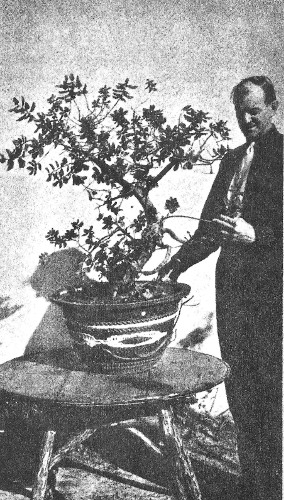
Lee Holdakowski with California live oak valued at $25,000
(L'Allemand, Gordon "Dwarf Trees Come to America," Travel, January 1943, pp. 28-29, 32;
http://findagrave.com/cgi-bin/fg.cgi/%3C/www.linkedin.com/in/johnmacomber/fg.cgi?page=gr&GRid=3718127 ;
July 27, 1943, pg. 15? http://adventistdigitallibrary.org/islandora/object/adl:362756/datastream/FULL_TEXT/view ;
"Census Data for George Holdakowski," https://www.myrelatives.com/genealogy-directory/george-holdakowski ;
Oakland Tribune, Oct. 13, 1937, Vital Statistics, pg. 27 ;
See also this gettyimage photo,
http://www.gettyimages.com/detail/news-photo/by-systematically-pinching-off-new-growth-clipping-their-news-photo/499289181#by-systematically-pinching-off-new-growth-clipping-their-roots-and-picture-id499289181;
And a one pargraph summary of the Travel article is presented as the fourth paragraph on pg. 16 of the
July 27, 1943 edition of
The Youth's Instructor.)
SEE ALSO: Dec 2
(Travel, January, 1943, pg. 29) |
||||
| 23 |
1956 -- Frank J. Mihalic was born to first-generation bonsai tracher Anthony "Tony" Mihalic
in Ohio.
(In 1979, Frank would found "Ichiban Publishing," a publishing company dedicated to bonsai. He would go on
to write and publish "The art of Bonsai-CD ROM" (the first CD on bonsai in the world), "The art of Bonsai-VHS Video &
DVD", "The Art of Bonsai-Book," and "Bonsai Screen Saver Computer CD ROM." Frank would become co-owner of Wildwood
Gardens, a bonsai nursery founded in 1946 by his father. In 1999, 2001, and 2006, Frank would have his
tree selected as one of the top one hundred bonsai in the JAL World Bonsai Contest sponsored by Japan Airlines and
chosen by the board members of the Nippon Bonsai Association and Japan Bonsai Growers Cooperative. In 2000
Japan Airlines and the Nippon Bonsai Association would award the Top One Hundred winners a copy of Frank's Bonsai
Book and CD ROM. In 2000 Frank would be the first and only foreigner to be awarded a special membership in
the Cheju Bonsai Growers Association, in Cheju, Korea. In 2001, Frank would found the first bonsai magazine
on the Internet, www.bonsaionlinemagazine.com. In 2004,
Frank would publish the first bonsai book for children, Bonsai For Kids, and the following year the first
computer CD ROM for children, Bonsai for Kids. Also in 2005 there would be a Spanish translation of
the book as Bonsai Para Los Ninos. That year Frank would be elected for the first of two terms to the
Board of Directors of the American Bonsai Society (ABS). In 2006, Bonsai For Kids would be published
in Japanese and in French, and eventually also in Polish, German, Spanish, and Korean. One of Frank's trees
was first runner up in the North American "John Naka Award" presented by the ABS that year, and another would be
first runner up in the Bonsai Clubs International and Centre-sponsored World Wide Contest in Italy. From 2010
thru 2014 he would be on the Bonsai Clubs International (BCI) Board of Directors. In addition, Frank would
also become a sculptor and jewelry artist specializing in
Lost Wax Carving.
He would study the art of cameo carving at
Torre del Greco in Naples, Italy in 2010.
He would teach workshops at both the Polish and South Korean National Bonsai Shows, International Bonsai Arboretum
(1987, with his father Tony), conventions including BCI + Australia National Bonsai (2014), Bonsai Societies of
Florida (2017), Golden State Bonsai Federation (2017), both the Mid-America Bonsai Alliance and Mid-America Bonsai
Exhibit in 2010, MidAtlantic Bonsai Societies (2015, 2016), and American Bonsai Society (1998, 2006, 2007, 2013,
2016, and 2017).)
|
||||
| 24 |
1988 -- Ann Kimball Pipe, author of the 1964 book Bonsai, The Art of Dwarfing Trees, died in St.
Louis, MO at the age of 77. ("Ann K. Pipe - Death Record," http://death-records.mooseroots.com/l/161628672/Ann-K-Pipe) 2002 -- Stanley Chinn, a little-known penjing master while alive in Wheaton, MD, died from pneumonia. (Born some 60 years earlier in China, at a young age he trained for six years at his uncle's penjing nursery before they both came to the U.S. around 1950. Stanley never achieved more than a limited command of the English language and was detached from the modern world around him. He earned his living as a chef. Chinese clubs and churches up and down the East coast were where he taught penjing. In 2001 he invited the National Bonsai and Penjing Museum staff to visit his collection and select trees from his hundreds of penzai. Ten of the creations were chosen for accessioning into the Museum's collection. These included a Sichuan School dancing dragon style root-over-rock Trident maple, another Trident composition of five trees planted on the rock and all grafted together at different locations, and a naturalistic forest of Chinese elm. They now allow the representation at the Museum of all of the Chinese schools of dwarf potted trees instead of just the Lingnan. Twelve other trees became part of the Montreal Botanical Garden's collection and another -- also a root-over-rock Trident maple -- went to the Brooklyn Botanic Garden. [Fifty three more creations would be sold in a silent auction at the National Arboretum in autumn, raising approximately $8,000 for the National Bonsai and Penjing Museum. As James Rieden, a friend of Chinn's, would say after the auction, "This is probably the last time anyone will have the opportunity to see this many trees styled in the Chinese penjing method assembled in one spot."]) ("Recognizing the Work of a Master" by Adrian Higgins, Washington Post, Nov. 14, 2002, pg. H-6; "A Word from the Curator" by Jack Susic, NBF Bulletin, Winter 2002, Vol. XIII, No. 2, pg. 4; "My Memories of Stanley Chinn" by Janet Lanman, same source, pg. 4, and "Stanley Chinn: Master of Penjing" by Tony Meyer, same source, pg. 5.) 2025 -- Elsie Andrade passed away in Phoenix, AZ. (Her family had moved to Phoenix "from Pennsylvania when she was six. She was at the first meeting [of the Phoenix Bonsai Society in November 1962] but didn't sign up initially. She had been aware of the art of bonsai for a few years already. [Club sensei] Leroy Fujii remembered her as eagerly volunteering to be the secretary -- a decision not so readily made by others then. Her sister-in-law, Nadine Andrade, also did some gardening as a hobby. Nadine tried to trim landscape trees and shrubs in the style of bonsai before she also joined the club. She independently discovered bonsai at Paul [Matsusaki, club founder]'s nursery. Thinking about joining, she started talking to Elsie and discovered that the latter was already in the club!" (The PhxBS 1975-75 yearbook was dedicated to Elsie. Leroy, Elsie and Nadine Andrade accompanied long-time honorary club sensei John Naka on a three-week tour of bonsai nurseries and other sites in Japan in 1977. Elsie attended the first World Bonsai Convention in Omiya, Japan in April 1989. She also had a side trip to Hong Kong from there. The 1990-91 yearbook was dedicated to the enduring commitment and often unsung contributions of Elsie. In 1992 she attended the 2nd World Bonsai Convention in Orlando, FL. Elsie was the subject of or source for information about bonsai for a few local newspaper articles (either by herself or with others) in October 1971, April 1974, June 1984, September 1991, August 1994, and February 2002. For several years Elsie and fellow PhxBS club member Penny Schneck regularly helped out at the horticulture and floriculture booths and displays at the Arizona State Fair. At an end-of-year club meeting in May 1996 she displayed an animal-shaped suiseki, 11 x 5 x 4-1/2", she had found before it was sent to the National Viewing Stone Collection in Washington, D.C. which had accepted it. The stone had been discovered in what was now a closed-off portion of Panamint Valley on the western edge of Death Valley National Monument, collected before Panamint was incorporated into Death Valley. (In the Fall of 1993 Elsie had conducted a hands-on demonstration for the Phoenix club of the technique of making a stand or dais for a suiseki using the automotive body putty Bondo®. Traditional stands are individually carved wood, but this contemporary method takes less time and is not so skill-intensive. The Bondo® stand she created for her donated suiseki three years hence would take five tries to result in a suitable base.) (She was Phoenix Club Treasurer 1971-79, Social Committee 1979-83 and 85-87, President 1983-85 (the first female president in the club), Education Committee Chair 2009-19, and Mentor 2008-2025. She served also as an American Bonsai Society Director 1985, 1988, 1994-95, 1997-2003; ABS Secretary 1990-93, and ABS President in 1997. (In an interesting coincidence, May Bloomer up the road in Flagstaff, AZ was the Bonsai Clubs International President that year as well.) At the Golden State Bonsai Federation Awards Dinner in early November 2009 in Riverside, CA, [fellow PhxBS founder] Joan McCarter and Elsie Andrade (along with Tucson's David Meyer) received their Bonsai Basics Teacher Certifications. In June 2010 Jim Andrade, Elsie's husband and partner for 53 years, passed away. The first weekend in December 2016 saw the Great California Suiseki search hosted by California teacher Cindy Read and Elsie Andrade. In 2019 Elsie assisted and facilitated the certifying process of four Phoenix club members as Bonsai Basics Teachers with the GSBF.)
(Facebook post by Phoenix Bonsai Society, March 24, 2025; Seago, Kate "Bonsai, The ancient Japanese art of training miniature trees," Arizona Spirit, June 6, 1984, pp. A12-13. With three b&w photos ; The Indices 2004, ABS, pp. 14, 15, 16, 17 ; "Our Other Officers" ; Baran, Robert J. Designing Dwarfs in the Desert, 1997, pp. 25, 40, 44, 46, 47, 55, 59, 63, 64, 65, 67, 68, 70, 72 ; "Phoenix Bonsai Society Club History Highlights") SEE ALSO: Apr 6, May 2, Nov 1, Dec 27 |
||||
| 25 |
1995 -- An olive bonsai, originally collected from an olive ranch in Fontana, CA on July 4, 1958 and then
also designed by him, was donated this day by John Naka to the Golden State Bonsai
Federation Collection at the Huntington Botanic Garden.
("GSBF Collection at the Huntington,"
http://www.gsbf-bonsai.org/huntington/GSBFHuntGalleryBonsai.html, accessed 03/17/03)
|
||||
| 26 |
1921 -- Doris Froning was born in South Bend, IN, where she would spend most of her childhood. [She would move to Wilmington, DE in
June 1940 upon her marriage to J. Fendall Froning. In 1949, the family would move to Kennett Square, PA. There she would raise
five children and be an active volunteer in the Girl and Boy Scouts and the Seedlings Garden Club. [She would later say, "While walking the dog one day in 1961 I saw an Eastern white pine that was much smaller than the rest of the pines we had planted around the perimeter of our property. It seemed to be a dwarf variety of Pinus strobus. Having read about bonsai (I think it was in House Beautiful [here?]) I dug it up and pretended I knew something about this ancient art. Once dug and planted I was hooked. Since that day in 1961 I have studied, written, and obsessed about bonsai. ["The first formal bonsai lessons I took were at Longwood Gardens. In 1967 Yuji Yoshimura taught a six day class, one for beginners and one for intermediates. Naturally I assumed I knew more than a beginner so I enrolled in the intermediate class but Mr. Yoshimura was polite and let me stay. We did a tree each of the six days. Prices were cheap. I bought a Kumquat for $2.50, three pots for $7.50, and five Zelkova for $1.00 each. The six days so stimulated me that no tree was safe. I created, dug plants, bought pots, and was in heaven. ["Around 1967 I became very interested in shohin (six inches or shorter in height) bonsai and my trees kept getting smaller and smaller. On our first trip to Japan I bought small pots and small stands and any book that had shohin bonsai on the cover. My husband said I had a hand carry on every finger on the flight home! ["My first attempts at shohin bonsai were not all that successful since I immediately put everything into a small pot not realizing that in a tablespoon of soil and a small pot, the tree would not grow very fast. I started to put seedlings into a ground bed to thicken the trunks. After a year or two in the ground, the trees were thickened and I could shape the branches into the style I wanted. The following spring the roots were reduced to fit into a small pot. ["As I became more and more interested in little trees, Dorothy Young and John Naka persuaded me to start a newsletter for little trees. In 1975 I began publishing Mame Bonsai Growers of America. I used mame in the title since the term shohin was little known at the time. MBGA was rather a pretentious title that initially had twenty-five members and cost $2.50. (I wrote the letter for twenty years and in 1995 we had over 325 readers and it cost $5.00.) [In the 1970s I started to travel and teach about bonsai and especially about shohin bonsai. I would often tell my audience that I started bonsai when I was 6'2" and before I got into bonsai I was 5'7" (I am actually 4'11). Some have called me mame mama." [Dorie would also be president of the America Bonsai Society and editor of its ABStracts newsletter. She would be a frequent contributor to various bonsai magazines including International Bonsai, conduct numerous lecture/demonstrations, be five year president of the new Brandwine Bonsai Society (est. 1967), and be active in the Pennsylvania Bonsai Society. At least one of her tiny trees would be in the North American Collection of the National Bonsai & Penjing Museum -- a trident maple started in 1976] 
Doris W. Froning
("IBC Stars," Bonsai, BCI, Vol. XXVII, No. 2, March/April 1988; conversation with RJB during the International
Scholarly Symposium on Bonsai and Viewing Stones, May 18, 2002, Washington, D.C.; Brandywine Bonsai Society,
March 2011
newsletter, pp. 1-2, cited as being from "Dorie's Shohin Bonsai Tips, How I started Growing Bonsai" by Doris W. Froning,
International Bonsai, 2002/2, p. 32; "Brandywine Bonsai Society History,"
http://www.gobbs.org/history.htm; "Doris W. Froning (1921 - 2014)" obituary, published in
The News Journal on Aug. 7, 2014,
http://www.legacy.com/obituaries/delawareonline/obituary.aspx?pid=171999308.)
SEE ALSO: Aug 4
(Bonsai Journal, ABS, Winter 1985, pg. 1) |
||||
| 27 |
1985 -- A collection of thirty prized penjing donated by third-generation
artist Yee-Sun Wu of Hong Kong to the Montreal Botanic Garden was unveiled.
[Within four months almost a quarter million people would visit the collection
which was receiving excellent care. So much major local and national
radio, television, and print coverage was given to the trees that Mr. Wu
would donate another seventeen of his outstanding treasures to the City
of Montreal before the year ended.]
(
International Bonsai, 1985/No. 4, pg. 20) SEE ALSO: Mar 16, May
2, May 11, July 7, Dec 14
1999 -- A set of four postage stamps commemorating the Bonsai Exhibition
there was issued by the
Republic of San Marino.
SEE ALSO: Jan 23, Jan 29, Feb 3, Feb 16, Mar 1, Mar 31, Apr 3, Apr 6, Apr 18, May 6, May 29, Jun
16, Jul 20, Aug 20, Aug 22, Sep 22, Oct 1, Oct 4, Dec 9.
|
||||
| 28 |
1940 -- Noboru Kaneko was born in Japan. [After studying the technique of bonsai art in Saburō
Katō's Mansei-en Nursery, Noboru would establish his own nursery, Issei-en (or Isei-en) east of the
main Bonsai Village in Omiya. His fine work would be recognized with at least three prizes in the
Sakufu Ten exposition for bonsai professionals and by his appointment as a board member of the Nippon
Bonsai Association.]
(
Bonsai Today, No. 24, pg. 12)
1983 -- A Japanese White Pine and a persimmon bonsai were presented
to President and Mrs. Ronald Reagan by
His Majesty Hassan II, king of
Morocco. The trees came from his personal collection.
("Spring Festival Celebrates Asian Horticultural Arts - Bonsai, Ikebana, Suiseki
in Spotlight," Friends of the National Arboretum,
http://www.fona.org/members/spring01/festival.html
;
The National Arboretum Book of Outstanding Garden Plants
by Jacqueline Hériteau, NY: Simon & Schuster; 1990, pp. xx)
1996 -- Beginning today and running through Aug. 18, the Asia Society Galleries in New York presented "Worlds within Worlds: The Richard Rosenblum Collection of Chinese Scholars' Rocks." More than 70 examples of this art assembled by an American sculptor over the past 25 years provided a strangely provocative exhibition, full of beautiful and sometimes haunting objects that make us question where we are standing when we look at nature and see art. Although most of the rocks were but a few inches high and sitting on carved wooden bases, the outstanding example was nearly six feet tall and just nine inches wide. Honorable Old Man (16th - 17th century) was craggy and rough as a tree branch, the stripped down image of a Chinese sage. Its inscription was effaced and its pedestal removed in the 1960s to disguise it as a mere rock, and thus save it from the iconoclasts of the Cultural Revolution. ("chinese scholars' rocks, simultaneously original and simulacrum" by John Mendelsohn, http://www.artnet.com/magazine/features/mendelsohn/mendelsohn8-26-96.asp) 2010 -- Omiya Bonsai Art Museum opened in Saitama, Japan, with the commemoration running through May 5. This is the world's first publicly-run museum of its kind. The collection of the former Takagi Bonsai Museum of Art formed the nucleus, as well as bonsai pots, stones of appreciation (Suiseki), and paintings such as ukiyo-e wood block paintings depicting bonsai. Four TV channels, four radio broadcasts, and twenty newspapers covered the openeing. The museum will pursue three pillars of activities: Firstly, it will conduct investigations and research into the history and significance of various bonsai and bonsai-related traditional arts from multiple perspectives including art history, craft history and the history of horticulture. The high-level results would then be made public in an easily understandable way through exhibitions, courses, lectures and publications. Secondly, as a new attraction on par with the Railway Museum, the Bonsai Museum seeks to become a sightseeing hub where not only local citizens, but also visitors from throughout Japan and abroad can readily experience how magnificent and interesting bonsai is. Thirdly, visitors to the museum may also visit the city's bonsai gardens in and around the Bonsai Village, becoming strong supporters of the bonsai industry as a traditional industry. At any one time the new museum will be displaying 60 of their 104 top quality bonsai, cared for by the three gardeners on the dozen-person staff. [The rest, stored in another garden, would be rotated into display as the seasons change. Fifty thousand visitors per year were originally to be attracted -- but sixteen thousand would have already visited during the first two months! A recent video of the Museum and some wonderful all-around close-ups of a few trees can be seen on this Omiya Bonsai video starting at the 13:50 mark.]
Floorplan, ©2010 The Omiya Bonsai Art Museum See this
article
on the meaning of bonsai by the museum's first director. From 2021 an
article
is here. And this recent video tour. ("Opening of Omiya Bonsai Art Museum," posting by hokkoku to Internet Bonsai Club Forum, 27 Mar 2010, http://ibonsaiclub.forumotion.com/announcements-f5/opening-of-omiya-bonsai-art-museum-t2631.htm; "Greeting," http://www.bonsai-art-museum.jp/english/sisetsu/greeting.php; Bourdeau, Louis-Victor "New bonsai museum in Omiya," Bonsai Focus, 130/107, 6/2010, Nov/Dec, pg. 22) SEE ALSO: Jan 4, Apr 27 |
||||
| 29 |
1956 -- Tony Tickle was born in Fareham,
Hampshire, UK. [He would study 3D Industrial Design at
Leeds Polytechnic and graduate in
1978. He would be introduced to bonsai in 1983. He would specialise in native European trees, in
particular: hawthorn (Crataegus), yew (Taxus), and pine (Pinus). Tony would train
under the stewardship of Japan's Takeo Kawabe and work with many of Europe's leading artists. After being UK
winner and runner-up in the European New Talent Competition in 1995, he would coach three UK new talent winners
including David Prescott in 1997 and Mike Sullivan who would win the Event in 1998 in Fermo, Italy. Tony
would win his first Ginkgo award in 1997 (and be selected for three others). He would win the
UBI Award (1997 and 1999) and
EBA Award of Merit (1999). He would
appear at the WBFF 4th Conference in Munich
in 2001. He would be a Director on the Board for Bonsai Clubs
International 2003-2005 and Member of the Association
of British Bonsai Artists. He would demonstrate at major conferences throughout the UK and Europe and
across the world, including Australia, South Africa, China, Brazil, India, and the USA. He would create
the annual Burrs events in 2004, with many
invited artists coming and sharing their talents with participants. Nominated for an award in 2009 at
the prestigious Noelanders Trophy in
Belgium, in 2017 he would win "Best Deciduous Bonsai" there. An event planner, in 2015 and again in
2017 he would organise Bonsai Europa, the BIGGEST bonsai event to take place in the UK since 1991. He
would be a founding member of "Black Scissors" in 2015, the global creative brotherhood of bonsai artists.
In October 2018 Tony would win a Bonsai Clubs International excellence award, only one of three presented that
year, for his cascade Mugo pine on a rock. In September 2019 he would organise the UK National Bonsai
show. He would have a regular column in the widest circulation bonsai magazine, Bonsai Focus,
and would also write for specialist publications such as Bonsai Today, BCI's Bonsai Magazine,
and China Penjing and Scholar Rock. Tony would seek to promote bonsai as an art form in its own
right, hosting exhibitions in Museums and Art Galleries along with unusual locations that capture the public
imagination. He would present bonsai in a creative and dynamic way courting controversy and praise in
equal measure. As a Royal Horticultural
Society judge, Tony would oversee the judging of competitions in the UK and as far afield as China and
Australia. He would champion the introduction of a fair and transparent judging system that is now
widely used across the global bonsai scene. Three questions he would ask when he viewed a tree in a
show: 1) Do you like it? 2) If it was your tree, what would you do to change it? and 3)Would you have it in
your garden? Over the years Tony would create hundreds of bonsai for himself, clients and students.
His website, https://yamadori.co.uk/, would date from at least the Fall
of 2000, his YouTube channel since November of 2007,
and his Facebook page since early 2014. He would also
support many ceramicists, especially in their early days.]
Tony Tickle's Hawthorn Raft at the XVIII Noelander's Trophy 2017
(Photo courtesy of Tony, 03/31/24) 
Tony Tickle's Taxus at the 2022 Bonsai Live Show
(Photo courtesy of Tony, 03/31/24) 
The Artist with a Pine
(Photo courtesy of Tony, 03/31/24) (Facebook Message from Tony to RJB, 03/31/24, correcting his birthplace to Fareham and providing 3 photos ; "About Tony," Bonsai & Yamadori from Tony Tickle ; "Tony Tickle," bonsaiempire.com ; "Tony Tickle, BCI) SEE ALSO: Nov 10, Nov 22, Dec 29 |
||||
| 30 |
|
||||
| 31 |
1940 -- Masahiko Kimura was born in Omiya, Japan, but originally his family had little
to do with the Bonsai industry. [His prolific inventor
father would die when Masahiko was 11, having committed suicide overwhelmed by the responsibility of
inventing weapons during the war, and this would deeply affect Masahiko. The comforts of early years would
change to harder times at their home, the "Peacock Garden" (named for the many peacocks on the grounds).
Land would be sold off to help in survival, and young Masahiko would go to work delivering papers to help
with the family finances. As he would later say, "My mother worked hard to bring us up, but we didn't
have money and I wasn't able to attend school. She thought bonsai would be a good career for me because
I was good with my hands." By the wishes of his mother, at age 15 he would start spending his time as an
apprentice under the bonsai master Motosuke Hamano of Toju-en Bonsai Garden where Masahiko was a part-time
worker. This would be for eleven years until about 1966. (Kimura would later say that during his
teens he really wanted to be a rock and roll musician. A usual apprenticeship is five years, but, as he
would later say, he had no money to start his own nursery so he would remain and continue his training with
Hamano-san.) "...after his apprenticeship and before he became a professional, there was a five year period of time where there was some conflict that existed that prevented him from being a bonsai professional... with the way that his apprenticeship ended and his relationship with his master, etc. And so he went to horticulture school at night, and that's actually where Mr. Kimura the Magician was born was because he physiologically started to understand how to execute trees, how to control them. He understood their vascular systems. He started understanding the nuances of controlling sugar and starch loads, and he really could tell you why, and that's what made him such a profound force in the west, whether he wanted to share that information or not..." A silent benefactor would finally help him open a greenery shop in Tokyo, and through long days of hard work Kimura would make it a success. Later he would manufacture potting soil and then expand into indoor plant rentals to hotels, restaurants and offices. This would also be successful, enabling him to devote more time to his bonsai. He would go on to become known as the "Magical Technician of Kindai Shuppan," though he would say that he personally didn't really care for the title of "Magician." His breathtaking sculpting and styling of trees on behalf of that Kyoto bonsai magazine publisher would be done using hand and power tools of his own design beginning in 1980. His skill with carving deadwood would quickly make him well-known in the bonsai community. While his work would at first be highly controversial, his energy and vision would soon became as respected as his art. A characteristic of his trees would be a defined interplay of artistically-sculptured deadwood with a smaller amount of more traditionally appearing live wood snaking up from the soil to foliage apex. Many of his trees would have a more elaborate starkness than is ordinarily found in the wild, innovatively creative without an historic model. Because of Kimura's willingness to break with convention, many in Japan would refuse to take him seriously, at least in the early years. Some would claim that these bonsai would not live after such drastic treatment. But his first thought would be that the trees he works on must live and he knew his critics were wrong. No one later would dispute Kimura's genius or his pioneering position in the bonsai world.] [The sometimes controversial author and videotape producer would travel in many countries, doing presentations and demonstrations. He would first demonstrate and conduct a workshop outside of Japan at the 1987 Golden State Federation Bonsai Convention in Anaheim, California. Kimura would then demonstrate at these major conventions, among others: Golden State Bonsai Federation (1990 Burlingame and 2006 Sacramento); World Bonsai Friendship Federation (1989 Omiya, Japan and 1997 Seoul, Korea); European Bonsai Association (1990 Turin, Italy and 1992 Luxembourg); Bonsai Clubs International (1992 Memphis, Tennessee, 1996 Washington, D.C. and 2006 Foshan City, China); American Bonsai Society Symposium (2000 Detroit, Michigan); Asia-Pacific Bonsai and Suiseki Exhibition and Convention (2003 Manila, Philippines and 2011 Takamatsu, Japan); Federatión Latino Americana de Bonsai (2003 Caracas, Venezuela); and Association of Australian Clubs (2005 Sydney). His work as documented in the form of articles and photographs would grace the pages of many major specialty publications around the world. Trees designed by him (mostly Juniperus chinensis var. shimpaku) would win the prestigious Prime Minister's Award for the years 1988, 1995, 2000, and 2001, and the Minister of Education Award in 1999. He would have a number of students and apprentices from Japan, Europe, and America, several of which would go on to become masters in their own right. These would include Marco Invernizzi, Salvatore Liporace, Marc Noelanders, Ernie Kuo, Kawabe Takeo, and Ryan Neil. Katsuhito Onishi would edit the Japanese texts The Magical Technician of Kindai Shuppan in 1982, Part II in 1984, and Part III in 1989. The English version, made up of Part II with some of Part I, would be published as The Bonsai Art of Kimura by Stone Lantern Publishing Co. in 1992. The Magician: the Bonsai Art of Kimura 2 would be released in 2007 by Stone Lantern. A Spanish translation, Masahiko Kimura: el técnico mágico del bonsai actual would be published in 1988 by Ediciones Tyris, S.A., and one in Italian, Masahiko Kimura, Il grande tecnico del bonsai, would be published by Luni in 1996. Kimura's wife, who often greeted tours to their Omiya garden and served tea and goodies to the visitors, would die November 23, 2009. See also episode #5 of Lindsay Farr's World of Bonsai, as well as this Spanish demo. And this 2016 excellent interview by Bonsai Empire.] [During the COVID-19 pandemic, Bonsai Empire in May 2020 presented a three-part four-hour on-line bonsai Masterclass by Kimura. And then there is this 2022 New Yorker magazine article about Ryan Neil's apprenticeship under Kimura. Note: there is some controversy about the exaggeration or accuracy of a few sections and quotes in this article based on five-year-old interviews. In March 2024 WABI Channel would present a fascinating two-part video conversation of Masahiko Kimura and Kunio Kobayashi, here and here. Ryan Neil would interview Australian Lindsay in an excellent two-part July 2024 podcast conversation which explores both of those artists, as well as a bit of further background about Masahiko Kimura. Part 1 can be heard here. Giving some insight into the audacity of bonsai innovators such as Kimura, Part II can be heard here, specifically marks 22:35 to about 40:00, 50:00 to 53:15, and 1:08:50 to 1:22:20.] 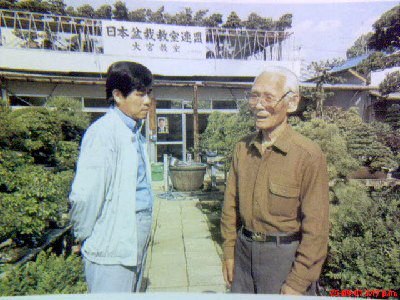
"Masahiko Kimura was also a student of the art of bonsai. Kimura and his master Gansuke Hamano. Master of masters."
(Photo from 13 Sep 2012 posting on NIPOWEB's Facebook page, https://www.facebook.com/pages/%E3%82%AB%E3%83%AB%E3%83%AD%E3%82%B9%E3%83%88%E3%83%BC%E3%83%AC%E3%82%B9-%E7%9B%86%E6%A0%BD-NIPOWEB/181293135287090) 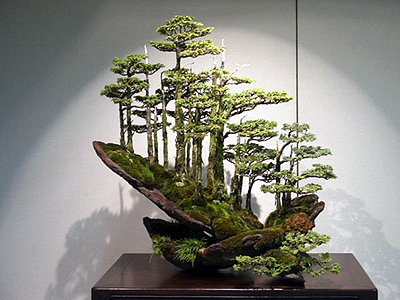
Masahiko Kimura's Cryptomeria Forest at Sakufuten, 10/03/2001.
(Photo courtesy of Alan Walker, 05/11/07) 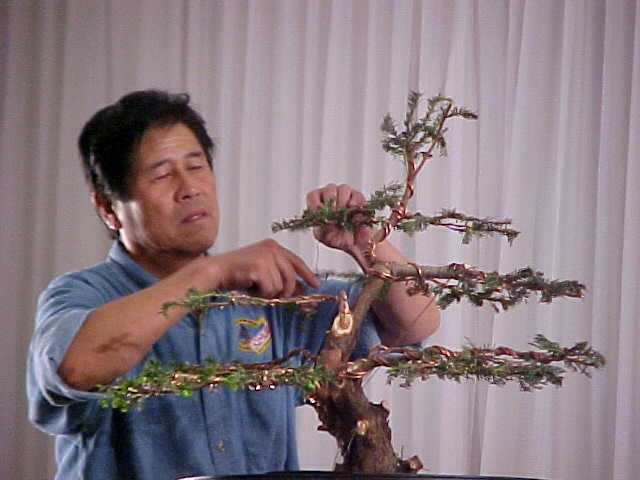
Masahiko Kimura in Argentina, 11/12/2003.
(Urbanski, Kay "The World of Masahiko Kimura," Bonsai Journal, ABS, Winter 1991, pp. 12-14; "Tree Art:
6 Amazingly Creative Bonsai Artists,"
http://webecoist.com/2009/06/09/tree-art-6-amazingly-creative-bonsai-artists/;
"Art of Bonsai Profile: Masahiko Kimura,"
http://www.artofbonsai.org/forum/viewtopic.php?t=942;
"Artist Profile: William N. Valavanis,"
http://bonsaijournal.com/profile-valavanis.php;
Lind, Gunter "Bonsai, Art and Kimura,"
http://www.bonsaipots.net/index.php?page=art-and-kimura;
"...after his apprenticeship" quote from Ryan Neil's conversation with
Dan Robinson: Part II, Bonsai Mirai: Asymmetry podcast,
06/01/2022, mark 52:00 to 52:52;
"The Magician: The Bonsai Art of Kimura 2,"
http://www.bonsaitrees.com/detail.php?id=710;
"Masterpieces," http://www.j-bonsai.com/masterpieces.html;
Liporace, Salvatore "Slanting a Juniperus prostrata to create the correct angle,"
http://www.bonsai4me.com/AdvTech/Liporace%20Demo%20page1.htm;
"Pacific Northwest Bonsai Clubs Association Bonsai Instructors,"
http://pnbca.com/instructors.html;
"Sad News From Omiya," William N. Valavanis posting to Internet Bonsai Club, 29 Nov 2009,
http://ibonsaiclub.forumotion.com/announcements-f5/sad-news-from-omiya-t1813.htm;
Masahiko Kimura: White Syrup, Green Clouds,
02/12/2012.)
(Photo courtesy of Alan Walker, 05/11/07) 1981 -- " Miniature landscapes," a set of six postage stamps, was issued by the Peoples' Republic of China (Mainland China). SEE ALSO: Jan 23, Jan 29, Feb 3, Feb 16, Mar 1, Mar 27, Apr 3, Apr 6, Apr 18, May 6, May 29, Jun 16, Jul 20, Aug 20, Aug 22, Sep 22, Oct 1, Oct 4, Dec 9. |
|
Also this month,
1965 --
Bonsai, Culture and Care of Miniature Trees was published, the first edition of Sunset
's book The illustrated 80-page 8.3 x 10.7" paperback had a list
price of $1.95. [The first printing of 17,500 copies would be sold out in a
month, and 6,000 more would be sold in the next few months. It would be the most
successful of the 18 low-priced gardening books that Lane Books Co. of
Menlo Park, CA had published at that time. It would be in its tenth
printing by April 1970, with a revised 80-page second edition published
in 1976 for $2.95, a revised 96-page third edition in May 1994 for
$9.95, and a revised 128-page fourth edition by Susan Lang in January
2003 with a list price of $14.95. Each edition would be a reasonable
introduction to this wonder-filled art/hobby.]
1968 -- The Fresno Bonsai society held its first public display of trees in a joint show with the Fresno Chapter of Ikebana International. That show was held at the Fresno Art Center. (A handful of plant lovers, gardeners and people who were learning bonsai had met informally, during the middle to late 1950s. These gatherings led to something more like a "club," which became then the Bonsai Club of Fresno. Early in the 1960s, the Bonsai Club of Fresno took the new name of Fresno Bonsai Society. At that time the society catered to a lot of so-called "plant people" who grew everything from bonsai to desert cactus to African violets. The rapidly growing club was divided almost equally among men and women and was very social.) [The 1968 show would raise funds to landscape the arts center courtyard and begin a Japanese Garden then being planned at Woodward Park. About five years after the joint show would come the society's first public bonsai-only show. In the mid-1970s the group would formally incorporate and in 1978 the Fresno Bonsai Society would become one of the first local affiliates to join the Golden State Bonsai Federation in 1978.] (Wasserman, Jim "FBS History," http://www.gsbf-bonsai.org/fresnobonsai/bonsai/fresnobonsai/fresno_bonsai_society1.htm) SEE ALSO: Feb 25, Apr 6. 2009 -- Seven hundred years ago this month, the series of twenty scrolls comprising Kasuga-gongen-genki ( Picture Scroll of the Incarnations and Miracles at the Kasuga Temple ) was presented to the Kasuga Shrine in Nara, Japan for dedication. This was the patron shrine of the Fujiwara family. The series depict some 56 miraculous accounts which occurred between 937 and 1304. In particular, the fifth scroll contains images of the residence of a Fujiwara governor named Toshimori (1120-c.1180). A birdcage and tray landscapes add to the revelation of the owner's wealth along with the spaciousness and rich decoration of the architecture. The miniature landscapes are probably exotics imported from China. This scroll is the third oldest but most widely known of the oldest authenticated Japanese depictions of dwarfed potted trees.
|
